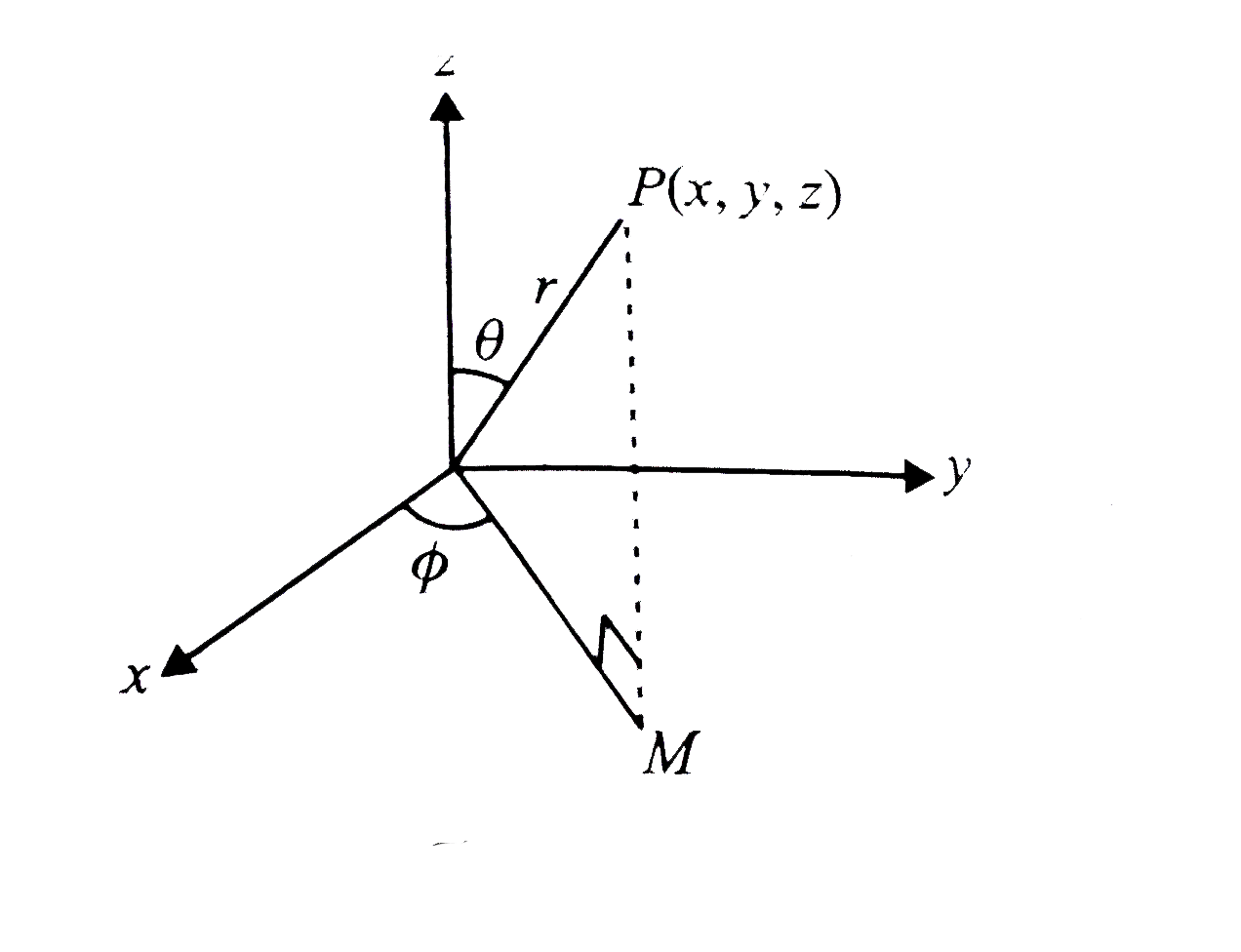Let PM be the perpendicular from the point P(1,2,3) to the x−y plane. If →OP makes an angle θ with the positive direction of the z− axis and→OM makes an angle φ with the positive direction of x− axis, whereO is the origin and θandφ are acute angels, then a. cosθcosφ=1/√14 b. sinθsinφ=2/√14 c. tanφ=2 d. tanθ=√5/3Solution in Bengali
cosθcosϕ=1/√14
sinθsinϕ=2/√14
tanϕ=2
tanθ=√5/3
The correct Answer is:b, c, d
If P be (x,y,z), then from the figure,
x=rsinθcosϕ,y=rsinθsinϕandz=rcosθ
1=rsinθcosϕ,2=rsinθsinϕand3=rcosθ

⇒ 12+22+32=r2orr=±√14
∴ sinθcosϕ=1√14,sinθsinϕ
=2√14andcosθ=3√14
(neglecting negative sign as θandϕ are acute)
sinθsinϕsinθcosϕ=21ortanϕ=2
Also, tanθ=√5/3.
Topper's Solved these Questions
- THREE-DIMENSIONAL GEOMETRY BOOK - CENGAGE PUBLICATIONCHAPTER - THREE-DIMENSIONAL GEOMETRY EXERCISE - REASONING TYPE
10 Videos
- THREE-DIMENSIONAL GEOMETRY BOOK - CENGAGE PUBLICATIONCHAPTER - THREE-DIMENSIONAL GEOMETRY EXERCISE - LINKED COMPREHENSION TYPE
12 Videos
- THREE-DIMENSIONAL GEOMETRY BOOK - CENGAGE PUBLICATIONCHAPTER - THREE-DIMENSIONAL GEOMETRY EXERCISE - SINGLE CORRECT ANSWER TYPE
86 Videos
- THREE DIMENSIONAL GEOMETRYBOOK - CENGAGE PUBLICATIONCHAPTER - THREE DIMENSIONAL GEOMETRYEXERCISE - All Questions
291 Videos
- TRIGONOMETRIC EQUATIONSBOOK - CENGAGE PUBLICATIONCHAPTER - TRIGONOMETRIC EQUATIONSEXERCISE - Archives (Numerical value type)
4 Videos
Similar Questions
Statement 1: Lines →r=ˆi+ˆj−ˆk+λ(3ˆi−ˆj)and→r=4ˆi−ˆk+μ(2ˆi+3ˆk) intersect. Statement 2: →b×→d=0 , then lines →r=→a+λ→band→r=→c+λ→d do not intersect.
View SolutionGiven four points A(2,1,0),B(1,0,1),C(3,0,1)andD(0,0,2). Point D lies on a line L orthogonal to the plane determined by the points A, B and C.
The equation of the plane ABC is
View SolutionIn a three-dimensional xyz space , the equation x2−5x+6=0 represents a. Points b. planes c. curves d. pair of straight lines
View SolutionFind the angle between the line whose direction cosines are given by l+m+n=0andl2+m2−n2=0.
View SolutionThe number of all possible values of θ, where 0<θ<π, for which the system of equations (y+z)cos3θ=(xyz)sin3θ,xsin3θ=2cos3θy+2sin3θzand(xyz)sin3θ=(y+2z)cos3θ+ysin3θ have a solution (x0,y0,z0) wiith y0z0≠0 is
View SolutionLet PM be the perpendicular from the point P(1,2,3) to the x−y plane. If →OP makes an angle θ with the positive direction of the z− axis and→OM makes an angle ϕ with the positive direction of x− axis, whereO is the origin and θandϕ are acute angels, then a. cosθcosϕ=1/√14 b. sinθsinϕ=2/√14 c. tanϕ=2 d. tanθ=√5/3
View SolutionIf O be the origin and OP=r and OP makes an angle θ with the positive direction of x-axis and lies in the XY plane find the coordinates of P.
View SolutionLet PQ be the perpendicular form P(1,2,3) to xy-plane. If OP makes an angle theta with the positive direction of z-axis and OQ makes an angle ϕ with the positive direction of x-axis where O is the origin show that tanθ=√53andtanϕ=2.
View SolutionLet PN be the perpendicular from the point
P(1,2,3) to xy-plane. If OP makes an angle α
with positive direction of the z-axis and ON makes
an angle β with the positive direction of x-axis,
where O is the origin (αandβ are acute angles),
then
View SolutionLet PM be the perpendicular from the point P(1,2,3) to XY-plane. If OP makes an angle θ with the positive direction of the Z-axies and OM makes an angle Φ with the positive direction of X-axis, where O is the origin, then find θandΦ.
View SolutionLet PM be the perpendicular from the point P(1,2,3) to XY-plane. If OP makes an angle θ with the positive direction of the Z-axies and OM makes an angle Φ with the positive direction of X-axis, where O is the origin, θandΦ are acute angles, then
View Solutionमाना O मूलबिंदु हैं तथा OP=r तथा OP, x अक्ष की धन दिशा से θ कोण बनाती हैं तथा XY तल में स्थित बिंदु 'P ' के निर्देशांक ज्ञात कीजिये|
View SolutionLet PM be the perpendicular from the point P(1,2,3) to the x−y plane. If →OP makes an angle θ with the positive direction of the z− axis and→OM makes an angle ϕ with the positive direction of x− axis, whereO is the origin and θandϕ are acute angels, then a. cosθcosϕ=1/√14 b. sinθsinϕ=2/√14 c. tanϕ=2 d. tanθ=√5/3
View SolutionLet PM be the perpendicular from the point P(1,2,3) to the x−y plane. If →OP makes an angle θ with the positive direction of the z− axis and→OM makes an angle φ with the positive direction of x− axis, whereO is the origin and θandφ are acute angels, then a. cosθcosφ=1/√14 b. sinθsinφ=2/√14 c. tanφ=2 d. tanθ=√5/3
View Solutionयदि xy तल में बिन्दु P(1,2,3) से PM एक लम्ब हो, यदि −−→OP सदिश z-अक्ष की धनात्मक दिशा में कोण θ तथा −−→OM सदिश x. अक्ष की धनात्मक दिशा में कोण ϕ बनाते है, जहॉ O मूल बिन्दु और θ तथा ϕe न्यून कोण हों, तो
View SolutionIf P≡(1,2,3) and O is origin, then direction cosines of OP are: a)1,2,3 b)−1,−2,−3 c)1√14,2√14,3√14 d)−1√14,2√14,3√14
View Solution
